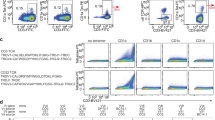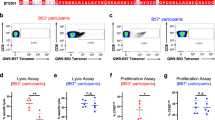Abstract
Plasticity of the T cell receptor (TCR) is a hallmark of major histocompatibility complex (MHC)–restricted T cell recognition. However, it is unclear whether interactions of TCR and peptide–MHC class I (pMHCI) always conform to this paradigm. Here we describe the structure of a TCR, ELS4, in its non-ligand-bound form and in complex with a prominent 'bulged' Epstein-Barr virus peptide bound to HLA-B*3501. This complex was atypical of previously characterized TCR-pMHCI interactions in that a rigid face of the TCR crumpled the bulged antigenic determinant. This peptide 'bulldozing' created a more featureless pMHCI determinant, allowing the TCR to maximize MHC class I contacts essential for MHC class I restriction of TCR recognition. Our findings represent a mechanism of antigen recognition whereby the plasticity of the T cell response is dictated mainly by adjustments in the MHC-bound peptide.
This is a preview of subscription content, access via your institution
Access options
Subscribe to this journal
Receive 12 print issues and online access
$209.00 per year
only $17.42 per issue
Buy this article
- Purchase on Springer Link
- Instant access to full article PDF
Prices may be subject to local taxes which are calculated during checkout





Similar content being viewed by others
References
Unanue, E.R. & Allen, P.M. The basis for the immunoregulatory role of macrophages and other accessory cells. Science 236, 551–557 (1987).
Townsend, A. & Bodmer, H. Antigen recognition by class I-restricted T lymphocytes. Annu. Rev. Immunol. 7, 601–624 (1989).
Bjorkman, P.J. et al. The foreign antigen binding site and T cell recognition regions of class I histocompatibility antigens. Nature 329, 512–518 (1987).
Arstila, T.P. et al. A direct estimate of the human T cell receptor diversity. Science 286, 958–961 (1999).
Maverakis, E., van den Elzen, P. & Sercarz, E.E. Self-reactive T cells and degeneracy of T cell recognition: evolving concepts–from sequence homology to shape mimicry and TCR flexibility. J. Autoimmun. 16, 201–209 (2001).
Garcia, K.C. et al. Structural basis of plasticity in T cell receptor recognition of a self peptide-MHC antigen. Science 279, 1166–1172 (1998).
Reiser, J.-B. et al. A T cell receptor CDR3β loop undergoes conformational changes of unprecedented magnitude upon binding to a peptide/MHC class I complex. Immunity 16, 345–354 (2002).
Kjer-Nielsen, L. et al. A structural basis for the selection of dominant αβ T cell receptors in antiviral Immunity. Immunity 18, 53–64 (2003).
Wu, L.C., Tuot, D.S., Lyons, D.S., Garcia, K.C. & Davis, M.M. Two-step binding mechanism for T-cell receptor recognition of peptide-MHC. Nature 418, 552–556 (2002).
Garcia, K.C. et al. An αβ T cell receptor structure at 2.5 Å and its orientation in the TCR-MHC complex. Science 274, 209–219 (1996).
Reiser, J.B. et al. CDR3 loop flexibility contributes to the degeneracy of TCR recognition. Nat. Immunol. 4, 241–247 (2003).
Borg, N.A. et al. The CDR3 regions of an immunodominant T cell receptor dictate the 'energetic landscape' of peptide-MHC recognition. Nat. Immunol. 6, 171–180 (2005).
Boniface, J.J., Reich, Z., Lyons, D.S. & Davis, M.M. Thermodynamics of T cell receptor binding to peptide–MHC: Evidence for a general mechanism of molecular scanning. Proc. Natl. Acad. Sci. USA 96, 11446–11451 (1999).
Housset, D. & Malissen, B. What do TCR-pMHC crystal structures teach us about MHC restriction and alloreactivity? Trends Immunol. 24, 429–437 (2003).
Ding, Y.-H., Baker, B.M., Garboczi, D.N., Biddison, W.E. & Wiley, D.C. Four A6-TCR/peptide/HLA-A2 structures that generate very different T cell signals are nearly identical. Immunity 11, 45–56 (1999).
Chen, J.-L. et al. Structural and kinetic basis for heightened immunogenicity of T cell vaccines. J. Exp. Med. 201, 1243–1255 (2005).
Luz, J.G. et al. Structural comparison of allogeneic and syngeneic T cell receptor-peptide-major histocompatibility complex complexes: a buried alloreactive mutation subtly alters peptide presentation substantially increasing Vβ Interactions. J. Exp. Med. 195, 1175–1186 (2002).
van der Merwe, P.A. & Davis, S.J. Molecular interactions mediating T cell antigen recognition. Annu. Rev. Immunol. 21, 659–684 (2003).
Garboczi, D.N. et al. Structure of the complex between human T-cell receptor, viral peptide and HLA-A2. Nature 384, 134–141 (1996).
Ding, Y.-H. et al. Two human T cell receptors bind in a similar diagonal mode to the HLA-A2/Tax peptide complex using different TCR amino acids. Immunity 8, 403–411 (1998).
Madden, D.R., Garboczi, D.N. & Wiley, D.C. The antigenic identity of peptide-MHC complexes: a comparison of the conformations of five viral peptides presented by HLA-A2. Cell 75, 693–708 (1993).
Burrows, S.R., Rossjohn, J. & McCluskey, J. Have we cut ourselves too short in mapping CTL epitopes? Trends Immunol. 27, 11–16 (2006).
Tynan, F.E. et al. T cell receptor recognition of a 'super-bulged' major histocompatability complex class I-bound peptide. Nat. Immunol. 6, 1114–1122 (2005).
Miles, J.J. et al. CTL Recognition of a bulged viral peptide involves biased TCR selection. J. Immunol. 175, 3826–3834 (2005).
Stewart-Jones, G.B., McMichael, A.J., Bell, J.I., Stuart, D.I. & Jones, E.Y. A structural basis for immunodominant human T cell receptor recognition. Nat. Immunol. 4, 657–663 (2003).
Rudolph, M.G., Stanfield, R.L. & Wilson, I.A. How TCRs bind MHCs, peptides, and coreceptors. Annu. Rev. Immunol. 24, 419–466 (2006).
Tynan, F.E. et al. High resolution structures of highly bulged viral epitopes bound to major histocompatibility complex class I: implications for T-cell receptor engagement and T-cell immunodominance. J. Biol. Chem. 280, 23900–23909 (2005).
Turner, S.J., Doherty, P.C., McCluskey, J. & Rossjohn, J. Structural determinants of T-cell receptor bias in immunity. Nat. Rev. Immunol. 6, 883–894 (2006).
Lefranc, M.P. IMGT, the international ImMunoGeneTics database. Nucleic Acids Res. 31, 307–310 (2003).
Kjer-Nielsen, L. et al. The 1.5 Å crystal structure of a highly selected antiviral T cell receptor provides evidence for a structural basis of immunodominance. Structure 10, 1521–1532 (2002).
Webb, A.I. et al. The structure of H-2Kb and Kbm8 complexed to a herpes simplex virus determinant: evidence for a conformational switch that governs T cell repertoire selection and viral resistance. J. Immunol. 173, 402–409 (2004).
Krogsgaard, M. & Davis, M.M. How T cells 'see' antigen. Nat. Immunol. 6, 239–245 (2005).
Baker, B.M., Turner, R.V., Gagnon, S.J., Wiley, D.C. & Biddison, W.E. Identification of a crucial energetic footprint on the α1 helix of human histocompatibility leukocyte antigen (HLA)-A2 that provides functional interactions for recognition by tax peptide/HLA-A2-specific T cell receptors. J. Exp. Med. 193, 551–562 (2001).
Davis-Harrison, R.L., Armstrong, K.M. & Baker, B.M. Two different T cell receptors use different thermodynamic strategies to recognize the same peptide/MHC ligand. J. Mol. Biol. 346, 533–550 (2005).
Ely, L.K. et al. Disparate thermodynamics governing T cell receptor-MHC-I interactions implicate extrinsic factors in guiding MHC restriction. Proc. Natl. Acad. Sci. USA 103, 6641–6646 (2006).
Davis, M.M. The problem of plain vanilla peptides. Nat. Immunol. 4, 649–650 (2003).
Turner, S.J. et al. Lack of prominent peptide-major histocompatibility complex features limits repertoire diversity in virus-specific CD8+ T cell populations. Nat. Immunol. 6, 382–389 (2005).
Miles, J.J. et al. TCRα genes direct MHC restriction in the potent human T cell response to a class I-bound viral epitope. J. Immunol. 177, 6804–6814 (2006).
Clements, C.S. et al. The production, purification and crystallisation of a soluble, heterodimeric form of a highly selected T-cell receptor in its unliganded and liganded state. Acta Crystallogr. D Biol. Crystallogr. 58, 2131–2134 (2002).
Boulter, J.M. et al. Stable, soluble T-cell receptor molecules for crystallization and therapeutics. Protein Eng. 16, 707–711 (2003).
Macdonald, W. et al. Identification of a dominant self-ligand bound to three HLA B44 alleles and the preliminary crystallographic analysis of recombinant forms of each complex. FEBS Lett. 527, 27–32 (2002).
Garboczi, D.N., Madden, D.R. & Wiley, D.C. Five viral peptide-HLA-A2 co-crystals: simultaneous space group determination and X-ray data collection. J. Mol. Biol. 239, 581–587 (1994).
Leslie, A.G.W. Recent changes to the MOSFLM package for processing film and image plate data. Joint CCP4 + ESF-EAMCB Newsletter on Protein Crystallography 26 (1992).
Collaborative. The CCP4 suite: programs for protein crystallography. Acta Crystallogr. D Biol. Crystallogr. 50, 760–763 (1994).
Emsley, P. & Cowtan, K. Coot: model-building tools for molecular graphics. Acta Crystallogr. D Biol. Crystallogr. 60, 2126–2132 (2004).
Humphrey, W., Dalke, A. & Schulten, K. VMD: Visual molecular dynamics. J. Mol. Graph. 14, 33–38 (1996).
Ferrieu, C., Ballester, B., Mathieu, J. & Drouet, E. Flow cytometry analysis of γ-radiation-induced Epstein-Barr virus reactivation in lymphocytes. Radiat. Res. 159, 268–273 (2003).
Williamson, N.A. & Purcell, A.W. Use of proteomics to define targets of T-cell immunity. Expert Rev. Proteomics 2, 367–380 (2005).
Purcell, A.W. et al. Quantitative and qualitative influences of tapasin on the class I peptide repertoire. J. Immunol. 166, 1016–1027 (2001).
Tynan, F.E. et al. The immunogenicity of a viral cytotoxic T cell epitope is controlled by its MHC-bound conformation. J. Exp. Med. 202, 1249–1260 (2005).
Acknowledgements
We thank the staff of Advanced Photon Source of the Industrial Macromolecular Crystallography Association for assistance in data collection, and D. El-Hassen for reagents. Supported by the Australian Research Council (Federation Fellowship to J.R.) and National Health and Medical Research Council (Peter Doherty Fellowship to N.A.B. and T.B.; Senior Research Fellowship to S.R.B. and to M.C.W.) and by grants from the Roche Organ Transplant Research Fund, the National Health and Medical Research Council and the Australian Research Council.
Author information
Authors and Affiliations
Contributions
F.E.T. and H.H.R. did experiments, interpreted data and helped prepare the manuscript; L.K.-N., J.J.M., M.C.J.W., L.K., N.A.B., N.A.W., T.B., A.W.P. and S.R.B. did experiments and interpreted data; and S.R.B., J.M., J.R. conceived experiments, interpreted data, supervised the project and helped prepare the manuscript.
Corresponding authors
Ethics declarations
Competing interests
The authors declare no competing financial interests.
Rights and permissions
About this article
Cite this article
Tynan, F., Reid, H., Kjer-Nielsen, L. et al. A T cell receptor flattens a bulged antigenic peptide presented by a major histocompatibility complex class I molecule. Nat Immunol 8, 268–276 (2007). https://doi.org/10.1038/ni1432
Received:
Accepted:
Published:
Issue Date:
DOI: https://doi.org/10.1038/ni1432
This article is cited by
-
Quantification of epitope abundance reveals the effect of direct and cross-presentation on influenza CTL responses
Nature Communications (2019)
-
Challenging immunodominance of influenza-specific CD8+ T cell responses restricted by the risk-associated HLA-A*68:01 allomorph
Nature Communications (2019)
-
DynaDom: structure-based prediction of T cell receptor inter-domain and T cell receptor-peptide-MHC (class I) association angles
BMC Structural Biology (2018)
-
HLA-B57 micropolymorphism defines the sequence and conformational breadth of the immunopeptidome
Nature Communications (2018)
-
Divergent T-cell receptor recognition modes of a HLA-I restricted extended tumour-associated peptide
Nature Communications (2018)



